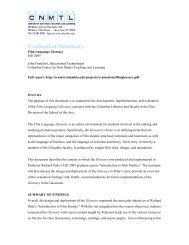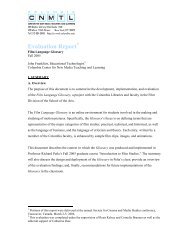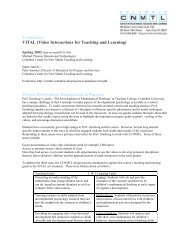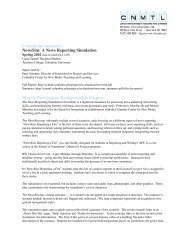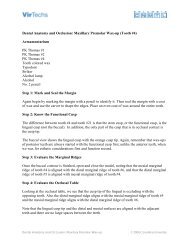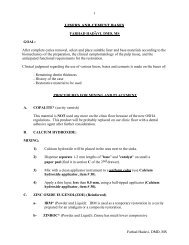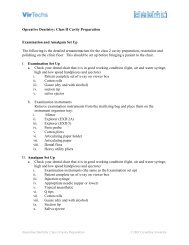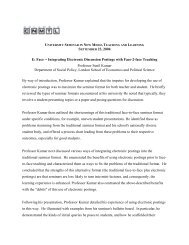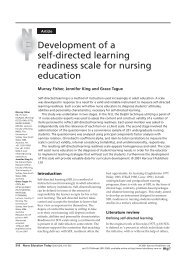Transcript for Stainless Steel Crown Restoration - Columbia University
Transcript for Stainless Steel Crown Restoration - Columbia University
Transcript for Stainless Steel Crown Restoration - Columbia University
You also want an ePaper? Increase the reach of your titles
YUMPU automatically turns print PDFs into web optimized ePapers that Google loves.
Step 2: Occlusal Reduction<br />
Once anesthesia is achieved, we're ready to begin the exercise. We select a #245 tapered fissure<br />
bur. Using the #245 bur, we want to produce pilot cuts or guide cuts on the occlusal surface,<br />
establishing a 1 mm depth cut. Then you connect all of the guide cuts. Thus producing a uni<strong>for</strong>m,<br />
occlusal reduction. I did the buccal surface, and I do the same thing from the lingual surface. The<br />
end result is a uni<strong>for</strong>m reduction that mimics the shape of the original tooth.<br />
Step 3: Proximal Reduction<br />
Then switch the bur to a #133F diamond. What you want to do is to slice directly through the<br />
proximal surface. Starting from the buccal surface, you want to reduce or eliminate the contact<br />
without creating a ledge in the proximal space, and/or damaging the approximating tooth. Switch<br />
to the distal surface. Per<strong>for</strong>m the same procedure.<br />
Then you can use an explorer (in this case we are using a perioprobe). Slide through the proximal<br />
surface to ensure that you don't have contact.<br />
Step 4: Round Line Angles<br />
You look at the preparation so far and you notice that it is occlusally square. Notice that you've<br />
squared off the distal and the mesial proximal walls, and that all these line angles are sharp. If<br />
you study the internal detail of the crown, everything is rounded. Your preparation needs to<br />
reflect that roundness. So we go back to the preparation and round or bevel all line angles.<br />
Step 5: Seat <strong>Crown</strong>, Check Occlusion, and Score <strong>Crown</strong><br />
Next take the pre-selected stainless steel crown and seat the lingual surface first, and with firm<br />
finger pressure, seat the crown over the prepared tooth. The snap indicates it's rolling over a<br />
height of contour, which is what gives you the retention that we're looking <strong>for</strong>.<br />
We then check the occlusion and can see that we're almost in occlusion, but most significantly is<br />
the fact that the crown is too long. If we take an explorer and tease back the gingiva, we see the<br />
crown length is in excess of 1 mm subgingival. So next we'll shorten the crown length so that the<br />
crown will seat to a position where the gingival margin of the crown is 1 mm below the free<br />
gingival margin.<br />
First we score a thin line using a sharp spoon excavator resting on the free gingival margin. If<br />
you use an explorer to do this procedure the scratch mark will be too wide so use a sharp spoon<br />
excavator. Do the same thing on the lingual surface. Then use the spoon excavator to lift the<br />
crown off of the prepared tooth.<br />
Step 6: <strong>Crown</strong> Adjustment<br />
Now study the position of the scratch line. You can see that the scratch line is well below, greater<br />
than 1 mm, longer than the position of the scratch line. So this crown needs to be shortened.<br />
Pediatrics: <strong>Stainless</strong> <strong>Steel</strong> <strong>Crown</strong> <strong>Restoration</strong> Page 2 of 4




